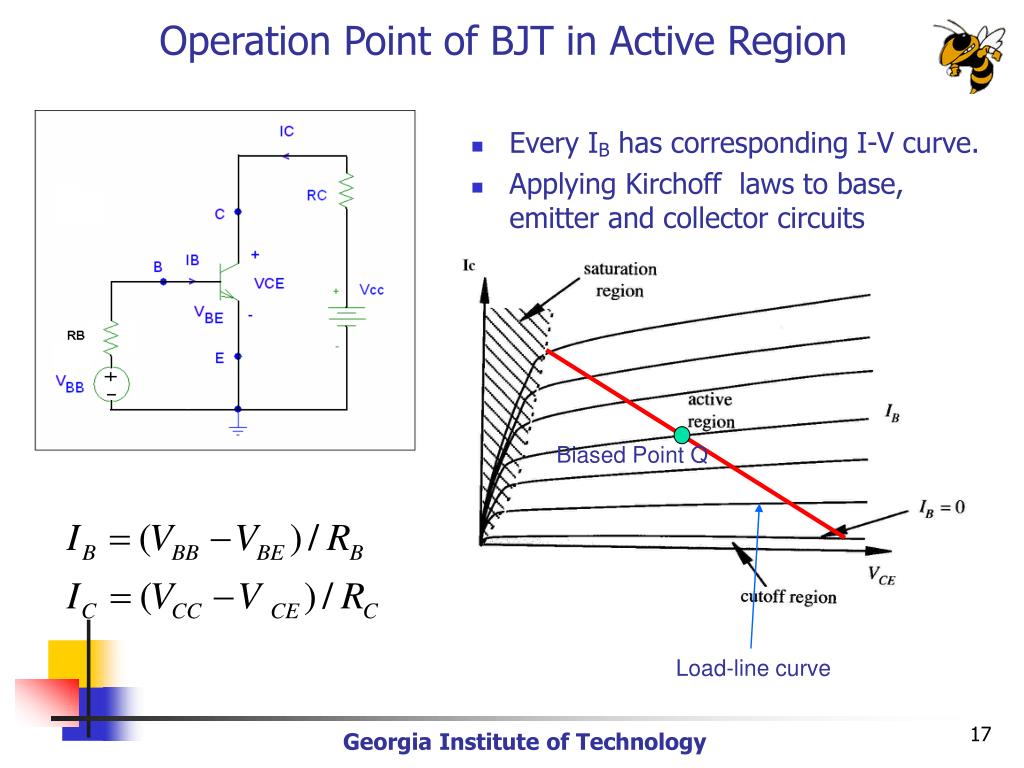

The DC base bias voltage is derived from the collector voltage V C, thus providing good stability. The collector to base feedback configuration ensures that the transistor is always biased in the active region regardless of the value of Beta ( β). This self biasing collector feedback configuration is another beta dependent biasing method which requires two resistors to provide the necessary DC bias for the transistor. Also the operating temperature of the transistor can adversely effect the operating point. With this single resistor type of biasing arrangement the biasing voltages and currents do not remain stable during transistor operation and can vary enormously. Then the value of R B is simply: (V CC – V BE)/I B where I B is defined as I C/β. Assuming a standard bipolar transistor, the forward base-emitter voltage drop would be 0.7V.

The emitter diode of the transistor is forward biased by applying the required positive base bias voltage via the current limiting resistor R B. This type of transistor biasing arrangement is also beta dependent biasing as the steady-state condition of operation is a function of the transistors beta β value, so the biasing point will vary over a wide range for transistors of the same type as the characteristics of the transistors will not be exactly the same. This two resistor biasing network is used to establish the initial operating region of the transistor using a fixed current bias. The circuit shown is called as a “fixed base bias circuit”, because the transistors base current, I B remains constant for given values of Vcc, and therefore the transistors operating point must also remain fixed. In this simple transistor biasing tutorial we will look at the different biasing arrangements available for a Common Emitter Amplifier. Base bias networks can be used for Common-base (CB), common-collector (CC) or common-emitter (CE) transistor configurations. Since the transistors Base bias currents are steady-state DC currents, the appropriate use of coupling and bypass capacitors will help block any biasing currents from other transistor stage affecting the bias conditions of the next. This steady-state or DC operating point is set by the values of the circuits DC supply voltage ( Vcc ) and the value of any biasing resistors connected the transistors Base terminal. The function of the “DC Bias level” is to correctly set the transistors Q-point by setting its Collector current ( I C ) to a constant and steady state value without any external input signal applied to the transistors Base. So how do we set this Q-point biasing of a transistor? – The correct biasing of the transistor is achieved using a process known commonly as Base Bias.īut before we start looking at the possible different transistor biasing arrangements, lets first remind ourselves of a basic single transistor circuit along with its voltages and currents as shown on the left.
#Transistor biased in active region full#
In other words, the output is available for the full 360 o of the input cycle.

This mode of operation allows the output voltage to increase and decrease around the amplifiers Q-point without distortion as the input signal swings through one complete cycle. When a bipolar transistor is biased so that the Q-point is near the middle of its operating range, that is approximately halfway between cut-off and saturation, it is said to be operating as a Class-A amplifier. This central operating point is called the “Quiescent Operating Point”, or Q-point for short. The correct biasing point for a bipolar transistor, either NPN or PNP, generally lies somewhere between the two extremes of operation with respect to it being either “fully-ON” or “fully-OFF” along its DC load line. Therefore, if the transistor is to operate correctly as a linear amplifier, it must be properly biased around its operating point as improper transistor biasing will result in a distorted output.Įstablishing the correct operating point requires the selection of bias resistors and load resistors to provide the appropriate input current and collector voltage conditions. The steady state operation of a bipolar transistor depends a great deal on its base current, collector voltage, and collector current values.


 0 kommentar(er)
0 kommentar(er)
